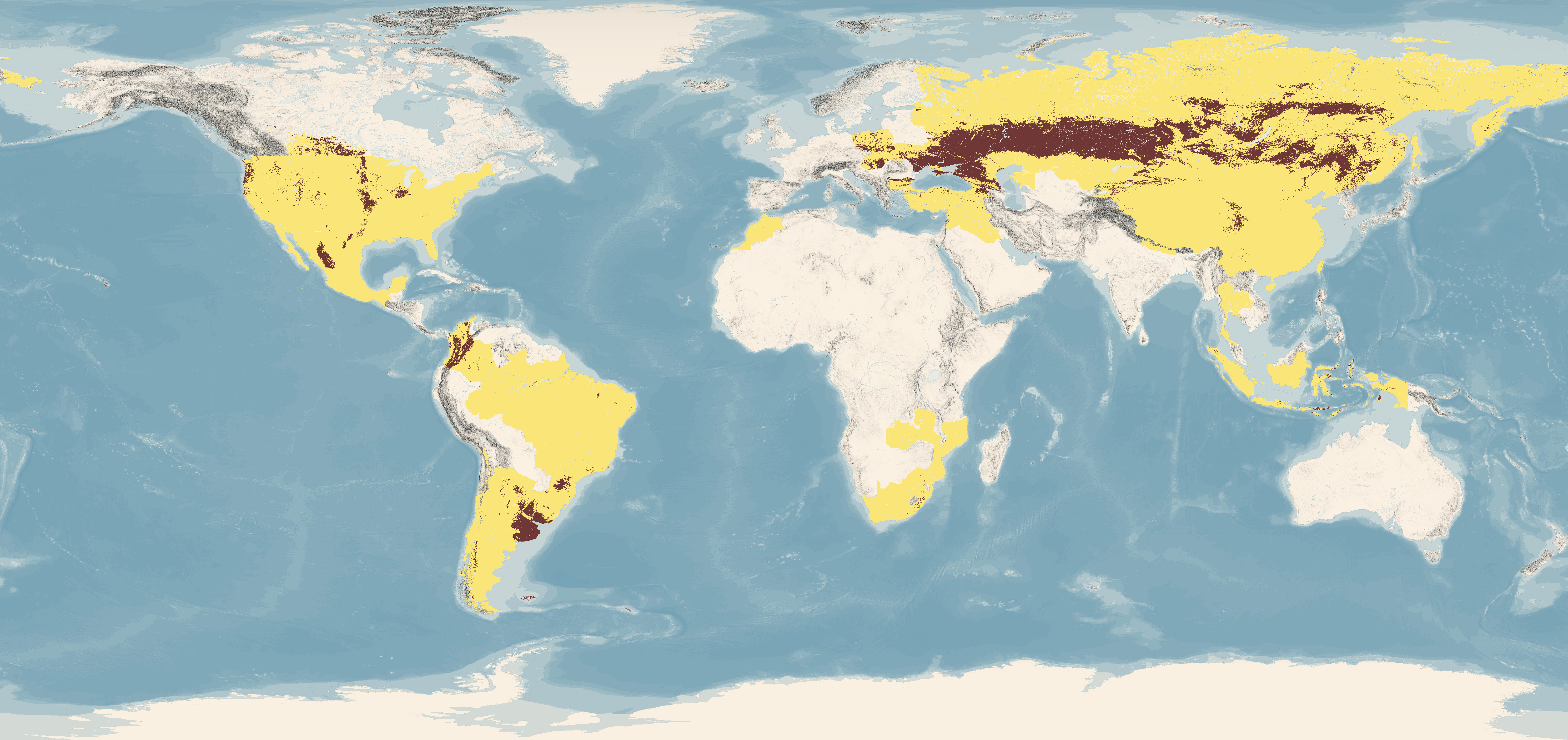Global Black Soil Distribution Map
GBSmap - v1.0

GBSmap - v1.0
Black soils are considered the food basket of the world.
Unfortunately, black soils are at great risk of severe degradation. This is why it has become crucial to develop a deeper understanding of the status of the black soils in the world including their distribution at national and global levels. During the second International Network of Black Soils (INBS) workshop in 2019, members discussed and agreed to develop a Global Black Soil Distribution Map (GBSmap) using a country-driven approach based on the endorsed definition of black soils. Two training sessions were organized in 2020-2021 to support INBS members in developing their national maps. Fourteen INBS countries subsequently developed and submitted their national black soil distribution maps.
There are an estimated 725 million hectares of black soils worldwide.
The Russian Federation has the largest area by far, followed by Kazakhstan and China. Black soil distribution strongly correlates with native prairie ecosystems including, but not limited to, other grassland ecosystems with a continental climate. Black soils are most prevalent in the mid-latitudes of North America, Eurasia, and South America. They are also found to a lesser extent in the tropical regions. At a global level, approximately one-third of black soils are covered with crops and another third by grasslands, with forests accounting for the remaining third. However, this distribution varies within each region. Read the press release
About Black Soils
Black soils are fundamental for food security globally and most of these special soils are found in the current conflict zone. Black soils also have a very high potential for carbon sequestration, thus key in the fight against climate change.
Explore the following resources:
Methodology
Countries and institutions contributing to the map
- National Institute of Agricultural Technology
- Armenian Scientific Center of Soil Science, Agrochemistry and Melioration after H. Petrosyan
- Embrapa Solos
- Universidade Federal da Paraíba
- Universidade Federal de Santa Maria
- Universidade do Estado do Amazonas
- Universidade Federal Rural do Rio de Janeiro
- Institute of soil science, agrotechnologies and plant protection Nikola Poushkarov
- Canadian Soil Information Service (CanSIS), Science and Technology Branch, Agriculture and Agri-Food Canada
- Departamento de Protección y Conservación de Suelos y Aguas, División de Protección de Recursos Naturales Renovables
- Heilongjiang Academy of Black Soil Conservation and Utilization, Heilongjiang Academy of Agricultural Sciences
- Institute of Soil Science,Chinese Academy of Science
- Nanjing Institute of Geography & Limnology, Chinese Academy of Science
- Agustín Codazzi Geographical Institute
- Joint Research Centre, European Commission
- Head of Laboratory of the Scientific-Research Center of MEPA, Associated professor
- Department of Crop Production and Soil Science, University of Pannonia
- Indonesian Center for Agricultural Land Resource Research and Development, Agency for Agricultural Research and Development, Ministry of Agriculture
- Office of Planning and Follow-up
- Uspanov Kazakh Research Institute on Soil Science and Agrochemisty
- Chairman of the teaching methods Commission
- Centro de Geociencias - Universidad Nacional Autónoma de México
- Secretaría de Agricultura y Desarrollo Rural
- Mongolian University of Life sciences Darkham-Uul
- INRA-Morocco
- Mozambique Agricultural Research Institute
- Soil Management Section, Department of Agriculture
- Institute of Soil Science and Plant Cultivation, State Research Institute
- University of Zielona Góra
- Scientific secretary, Institute of Pedology, Agrochemistry and Soil Protection
- Dokuchaev Soil Science Institute
- Irkutsk State University
- Lomonosov Moscow State University
- Russian State Agrarian University - Moscow Timiryazev Agricultural Academy
- Severtsov Institute of Ecology and Evolution of the Russian Academy of Sciences
- South Federal University
- National Agricultural and Food Centre, Soil Science and Conservation Research Institute, Banska Bystrica
- ARC-Institute for Soil, Climate, and Water
- General Commission of Scientifics Agriculture Research (GCSAR) Damascus – Syria/Institute of Geography, FAU Erlangen Nurnberg University
- Agricultural Research Officer, Office of Land Use Planning and Policy, Land Development Department, Ministry of Agriculture and Cooperatives
- Ministry of Food, Agriculture and Livestock
- National Scientific Center «Institute for Soil Science and Agrochemistry Research named after O.N. Sokolovsky», Kharkiv
- National Scientific Center «Institute for Soil Science and Agrochemistry Research named after O.N. Sokolovsky» (NSC ISSAR)
- United States Department of Agriculture USDA
- Directorate General of Natural Resources (DGRN) of the Ministry of Livestock, Agriculture and Fisheries (MGAP) for Uruguay
- General Direction of Natural Resources-Ministry of Livestock, Agriculture and Fisheries
- Ministry of Agriculture and Livestock
INBS coordinated the mapping process.

On-the-job trainings conducted in 2020-2021
Status of the World's Soil Resources. Main report and Technical summary (EN | ES | FR)
